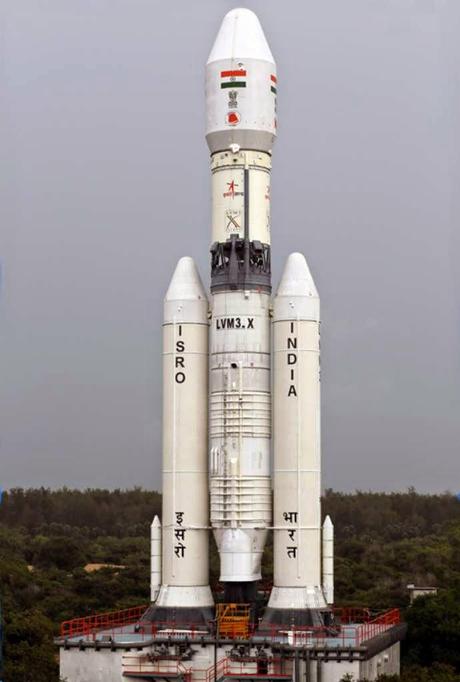 photo credit : isro.org
The GSLV-III or
Geosynchronous Satellite Launch Vehicle Mark III is a launch vehicle under
development by the Indian Space Research Organisation. It is intended to launch
satellites into geostationary orbit and as a launcher for an Indian crew
vehicle. The GSLV MK-3 will feature an Indian cryogenic third stage and a
higher payload capacity than the current GSLV.
Though called a crew module, it will not
carry any living being and is being sent up only to test its re-entry
characteristics. The 630-tonne rocket will be powered by liquid and solid fuel
engines while the cryogenic stage/ engine will be a passive one.
During the
countdown, the rocket's liquid fuel engine will be fueled up and the passive
cryogenic engine at the top will be filled with liquid nitrogen for mass
simulation, Prasad said. The actual
cryogenic engine to power the rocket carrying an around four tonne satellite is
under development and is expected to be ready in two years time. As the other
rocket engines are ready, ISRO decided to have this mission.
The experimental
mission will cost Rs. 155 crores and will not carry any satellite as the
cryogenic engine needed for the purpose is under development, ISRO spokesperson reiterated. The main
objective of the crew module is to demonstrate its re-entry flight and
aero-braking; end-to-end parachute system validation. The rocket will go up to
126km and then the crew capsule will be detached and it will fall into the Bay
of Bengal, 20 minutes after blast off. The descent speed of the crew module
will be controlled by onboard motors for some distance and then by three
parachutes.
The module will
splash down 600km from Port Blair and 1,600km from the space center. The
capsule will be recovered by an Indian Coast Guard or Indian Navy ship. The
crew module, looking like a giant-size cup cake - black in color on top and
brown at the bottom - weighs around four tonnes. According to an Indian Space
Research Organisation (Isro) official, it will be in the size of a small
bedroom and can accommodate 2-3 people.
It is stated that "The
crew module after being recovered from the sea will first be taken to the
Ennore Port (near Chennai) and from there it will be brought to Sriharikota.
From Sriharikota the module will be taken to VSSC (Vikram Sarabhai Space
Centre-Thiruvananthapuram)." Look
forward to great moments for the Nation and advancement in every field. Hamara Bharat Mahan hein.
photo credit : isro.org
The GSLV-III or
Geosynchronous Satellite Launch Vehicle Mark III is a launch vehicle under
development by the Indian Space Research Organisation. It is intended to launch
satellites into geostationary orbit and as a launcher for an Indian crew
vehicle. The GSLV MK-3 will feature an Indian cryogenic third stage and a
higher payload capacity than the current GSLV.
Though called a crew module, it will not
carry any living being and is being sent up only to test its re-entry
characteristics. The 630-tonne rocket will be powered by liquid and solid fuel
engines while the cryogenic stage/ engine will be a passive one.
During the
countdown, the rocket's liquid fuel engine will be fueled up and the passive
cryogenic engine at the top will be filled with liquid nitrogen for mass
simulation, Prasad said. The actual
cryogenic engine to power the rocket carrying an around four tonne satellite is
under development and is expected to be ready in two years time. As the other
rocket engines are ready, ISRO decided to have this mission.
The experimental
mission will cost Rs. 155 crores and will not carry any satellite as the
cryogenic engine needed for the purpose is under development, ISRO spokesperson reiterated. The main
objective of the crew module is to demonstrate its re-entry flight and
aero-braking; end-to-end parachute system validation. The rocket will go up to
126km and then the crew capsule will be detached and it will fall into the Bay
of Bengal, 20 minutes after blast off. The descent speed of the crew module
will be controlled by onboard motors for some distance and then by three
parachutes.
The module will
splash down 600km from Port Blair and 1,600km from the space center. The
capsule will be recovered by an Indian Coast Guard or Indian Navy ship. The
crew module, looking like a giant-size cup cake - black in color on top and
brown at the bottom - weighs around four tonnes. According to an Indian Space
Research Organisation (Isro) official, it will be in the size of a small
bedroom and can accommodate 2-3 people.
It is stated that "The
crew module after being recovered from the sea will first be taken to the
Ennore Port (near Chennai) and from there it will be brought to Sriharikota.
From Sriharikota the module will be taken to VSSC (Vikram Sarabhai Space
Centre-Thiruvananthapuram)." Look
forward to great moments for the Nation and advancement in every field. Hamara Bharat Mahan hein.
With regards – S. Sampathkumar 17th Dec 2014.

